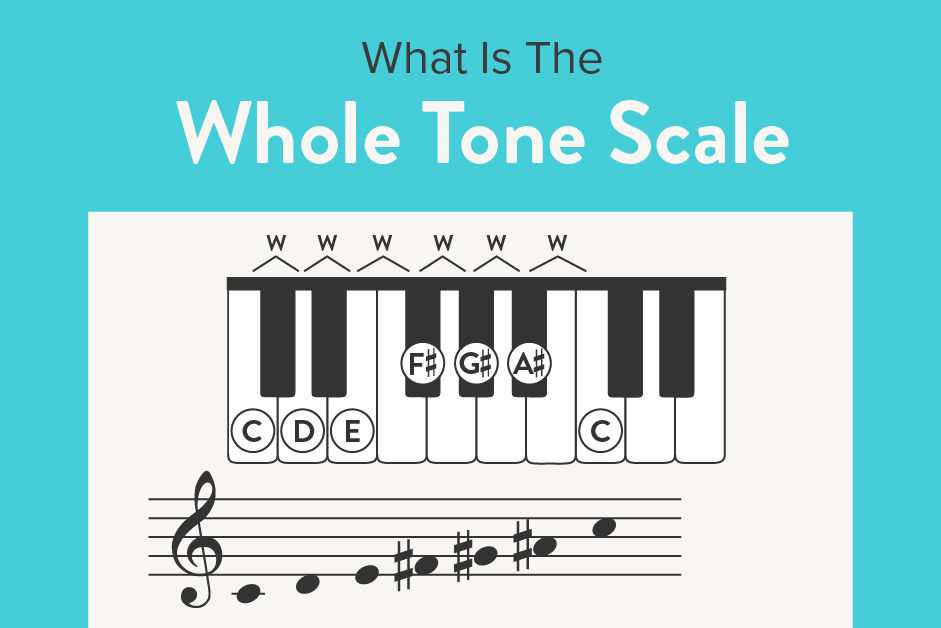Want to learn about the whole tone scale in music? Read on below!
Imagine a scale where each note seems to glide effortlessly into the next, with no jarring dissonances or strong harmonic pulls. This smooth, otherworldly scale is the whole tone scale. Dreamy and mysterious, it is popular with impressionist and avant-garde composers, and often appears in film scores to create suspenseful or fantastical atmospheres. In this article, we’re going to explore why this scale has such a distinct sound, see examples of it in pop culture, and learn how to play the scale on the piano.
Interested in learning more about different kinds of scales? Check out our free piano scales guide and sign up for Premium today!
What is the scale’s formula?
The scale is made entirely of whole steps (also known as tones). The formula for the scale is W-W-W-W-W-W. Pretty simple!
The whole tone scale is considered a symmetrical scale. This means you can start on any tone within the scale and have the same sequence of intervals ascending and descending. The whole tone scale has the notes C-D-E-F#-G#-A#-C. Let’s say we start on E instead of C. Our scale would still be E-F#-G#-A#-C-D-E. The root of the scale is different but all of the intervals are the same.
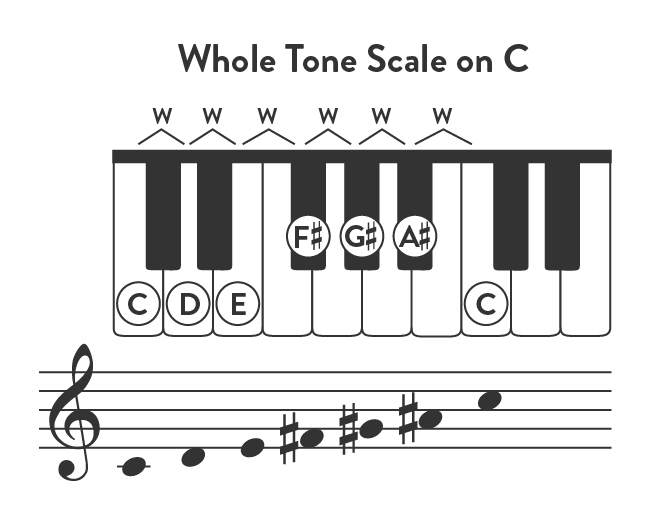 There are only two transpositions of the whole tone scale: one starting on C and the other on D-flat. To play the latter, start on Db and count up in whole steps: Db-Eb-F-G-A-B-Db.
There are only two transpositions of the whole tone scale: one starting on C and the other on D-flat. To play the latter, start on Db and count up in whole steps: Db-Eb-F-G-A-B-Db.
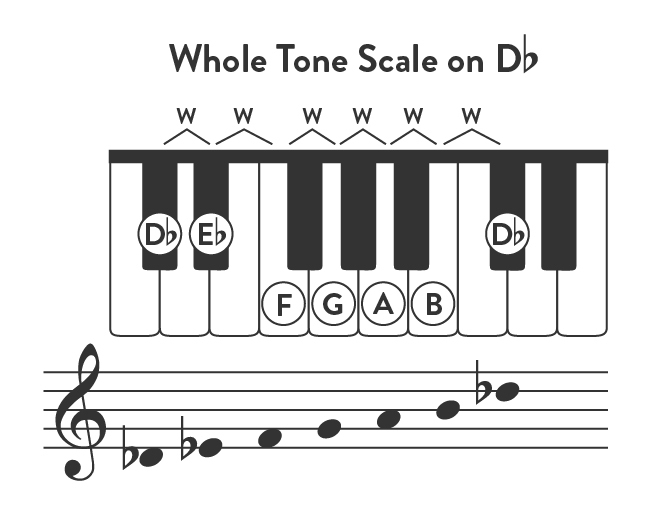
You might have noticed that for the whole tone scale starting on C, you play only white piano keys from C to E, then only black keys from F# to A#. For the whole tone scale starting on Db, you play only black keys from Db to Eb, then only white keys from F to B. Remembering to alternate between a set of three white keys and three black keys, or a set of two black keys and four white keys, can help you easily play the whole tone scale.
How is the whole tone scale different from a major scale?
The whole tone scale is fascinating because, unlike major and minor scales, it has no defined tonal center. In the C major scale (C-D-E-F-G-A-B-C), C is the tonic. In a piece written in C major, C is the note that feels like home and gives the strongest sense of resolution. However, the whole tone scale lacks that strong harmonic pull to the tonic. Due to the symmetry of the scale, it has no note that sounds more stable or resolved than the others. This lends itself to the ambiguous and suspenseful sound of the scale.
The reason is that the whole tone scale only uses whole steps while a major scale uses both whole and half steps. The pattern for major scales is W-W-H-W-W-W-H. This pattern of whole and half steps contributes to the scale’s harmonic tension and resolution in melodies and chords. However, the whole tone scale is unable to adhere to traditional harmonic functions because of its symmetrical structure.
How do you play the whole tone scale on piano?
The fingering differs from the fingering for major and minor scales. Here’s how to play the ascending scale starting on C:
Right hand:
1 on C
2 on D
Pass the thumb under:
1 on E
2 on F#
3 on G#
4 on A#
5 on C
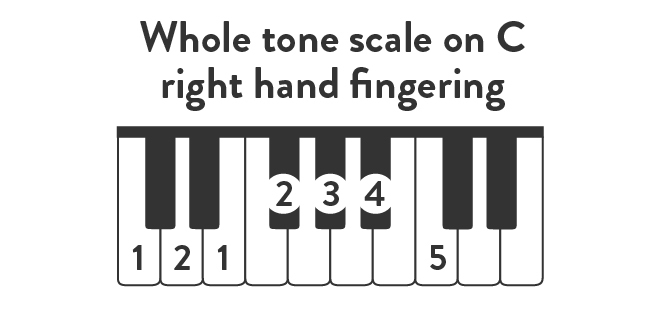
For your left hand, place fingers like this:
3 on C
2 on D
1 on E
Cross the 4th finger over:
4 on F#
3 on G#
2 on A#
1 on C
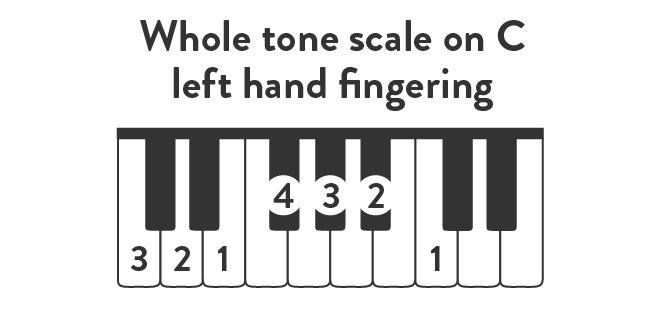
When coming down, reverse the finger order like this:
Right hand
5 on C
4 on A#
3 on G#
2 on F#
1 on E
Cross the 2nd finger over:
2 on E
1 on C
Left hand:
1 on C
2 on A#
3 on G#
4 on F#
Pass the thumb under:
1 on E
2 on D
3 on C
Chords
This scale is not traditionally associated with chords in the same way major and minor scales are. However, it’s still possible to derive cords from it by stacking thirds. There are only two augmented triads in each whole tone scale, each a step a part. An augmented triad is a chord composed of two major thirds. In the C whole tone scale, the two augmented triads are C augmented (C-E-G#) and D augmented (D, F#, and A#).
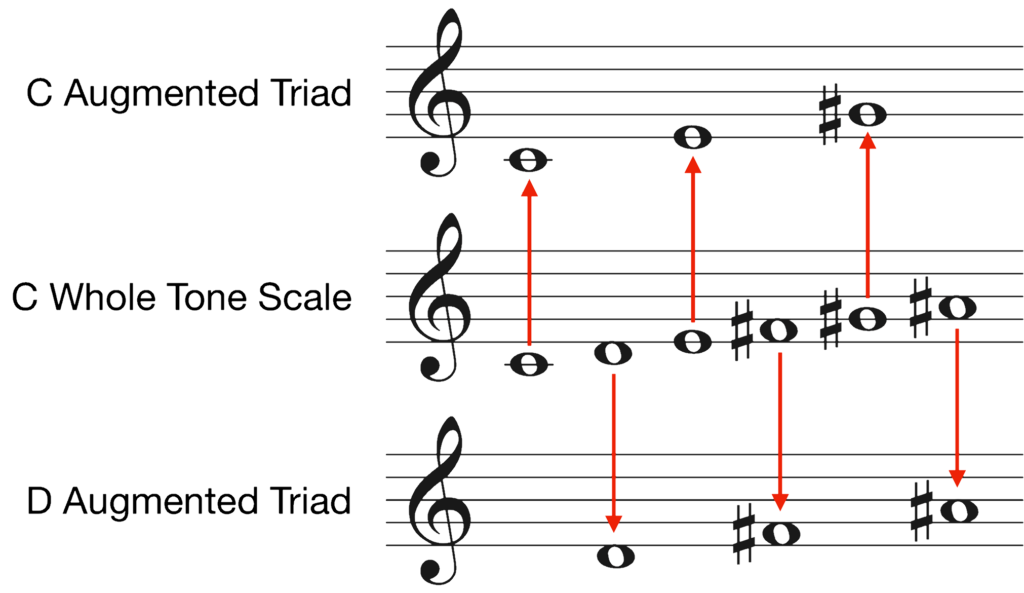
In the Db whole tone scale, the two augmented triads are Db augmented (Db-F-A) and Eb augmented (Eb-G-B).
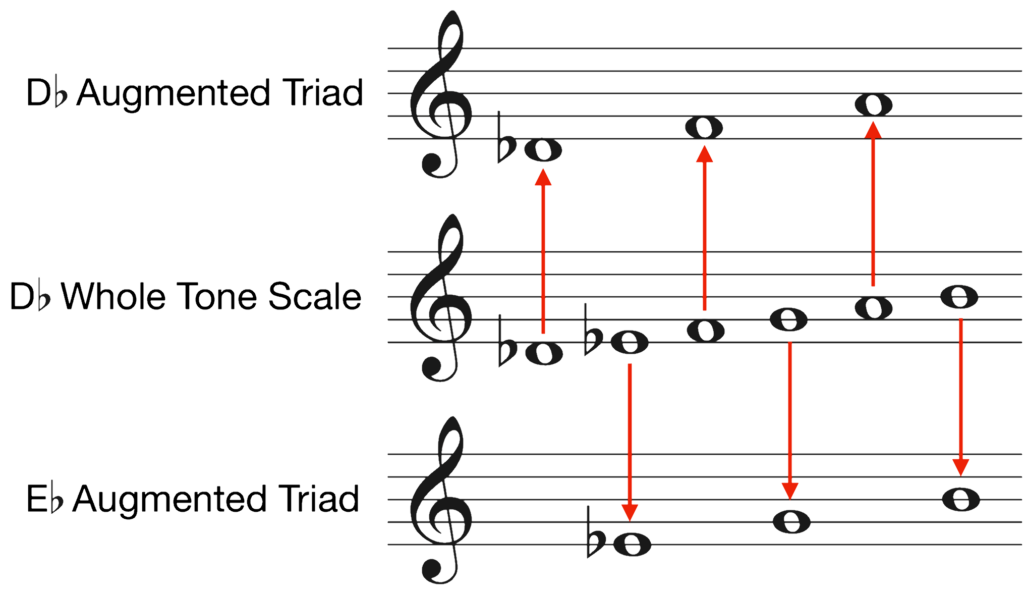
Music examples
This scale has been used in various genres of music and can be found in film scores, pop, jazz, rock, and classical music. Here are a few popular examples:
- Looney Tunes & Spongebob. The whole tone scale is often used in cartoons to indicate a shift in mood, often right before a flashback or a dream. Listen as Bugs Bunny or Spongebob drifts to sleep. Notice how the scale conveys a vague, sleepy feeling. It also expresses a change in the character’s state of mind.
- Voiles – Perhaps one of the most famous uses of the scale is in Impressionist music, such as this piano prelude by Claude Debussy. He uses the whole tone scale for almost the entire length of Voiles. The scale is distinct and creates an eerie atmosphere.
- You Are the Sunshine of my Life – In this Stevie Wonder song, you can hear the scale in the first 15 seconds on the intro. It adds a sense of wonder and optimism.
- Juju – Many jazz composers and improvisers have incorporated this scale into their compositions, including this piece from Wayne Shorter.
- The Bear – One of my favorite piano pieces to teach! A late elementary composition by Vladimir Rebikov, it uses the whole tone scale exclusively. Many students are surprised and intrigued by the piece’s atonal sound, which perfectly evokes the titular animal. It’s easy to imagine a bear tromping through the forest with playful abandon!
The whole tone scale is something of a chameleon. Depending on the context of the piece, the scale can be used to sound eerie, optimistic, dreamy, suspenseful, or intense. Take some time to learn the sound of the scale and soon you’ll be able to recognize it in a wide range of music!




